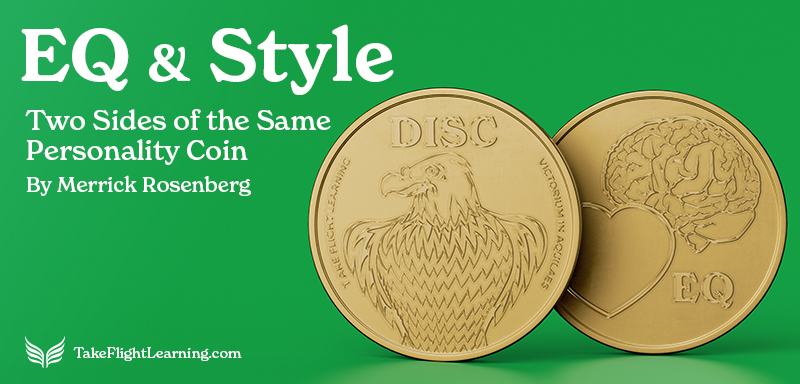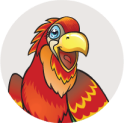EQ & Style – Two Sides of the Same Personality Coin
At Take Flight Learning, we used to treat personality styles and emotional intelligence (aka, EI or EQ) as separate. That was the norm in our industry. In recent years, however, I began to realize that style and EQ are two sides of the same personality coin. Without EQ, style can struggle to explain our behaviors and the emotions that drive them. Without style, EQ gives a limited view of why we feel the way we do.
Put another way, an emotionally intelligent Eagle (D in DISC) is different from an emotionally intelligent Dove (S in DISC). They may each have a high EQ, but they won’t express it the same way.
My purpose here is to discuss why and how we should integrate style and EQ. By doing so, I believe we can offer people more insight into who they are now and who they could become through developing emotional intelligence. When we combine the behaviors of the styles with the depth of EQ, the result is more than the sum of its parts. It is a way to become the very best versions of ourselves.
Before taking this idea further, let’s begin with some definitions:
What is style?
Styles are grounded in personality type theory and defined as a collection of traits that occur together. At Take Flight Learning, we use the DISC model, which is a classic styles-based framework. I refer to the Dominant Ds as Eagles who exhibit the common traits of being results-driven, competitive, take-charge, direct, and assertive. The Interactive I style refers to Parrots who are talkative, social, optimistic, energetic, and enthusiastic. Supportive Ss are Doves who are caring, empathetic, soft-spoken, loyal, and helpful. And Conscientious Cs are Owls who are logical, precise, questioning, diplomatic, and analytical.
What is emotional intelligence?
Emotional intelligence is the ability to perceive, recognize, evaluate, understand, and control one’s emotions. Measures of EQ reflect the extent to which individuals consciously choose how they think, feel, and act and how they influence the emotions of others. Studies repeatedly find that people with high EQ are more productive, motivated, and content. They have healthier relationships, more positive self-talk, lower stress, fewer health issues, and decreased bias.
What is personality?
The American Psychological Association defines personality as, “Individual differences in characteristic patterns of thinking, feeling and behaving.” Notice that personality is the integration of thoughts and feelings (EQ) and behaviors (style). Therefore, if people tap into the power of emotional intelligence and the styles, they have better odds of becoming the best version of themselves.
While anyone can experience any emotion, notice that each style has a set of predominant emotions that drive thoughts and behaviors:
- Eagles are prone to experience confidence, power, pride, and daring.
- Parrots experience joy, amusement, playfulness, and excitement.
- Doves experience feelings of peace, calm, open-heartedness, and appreciation.
- Owls experience curiosity, reflectiveness, apprehension, and clarity.
These emotions often drive behaviors characteristic of the style. For instance, a Parrot’s optimism and sense of adventure may lead them to take risks without thinking through the consequences. Meanwhile, an Owl’s thoughtful nature may lead them to fully assess the risks before acting.
Again, EQ and style are usually treated separately. But by integrating style into EQ, we can set style-specific goals and create action plans that are more personalized to how people think, feel, and act.
High and low EQ by style
Usually, EQ is based solely on a self-reported assessment, which can be misleading. Instead, let’s imagine EQ as a state of being and consider what each style looks like with high EQ or low EQ.
The high EQ description captures how a style reflects emotional awareness and management through outward behaviors and performance. It paints the picture of what a person can be at their best. The high EQ description also captures how that style may overuse its strengths. For example, a confident Eagle may display arrogance if they push confidence into the red zone.
The low EQ description captures how a style is prone to behave and perform when stress and discomfort cloud out their emotional awareness and management. The low EQ description can also provide a window back in time, illustrating less evolved versions of the same person.
The beauty of emotional intelligence is that it changes and can be developed. If an EQ score is low, the person can increase their EQ through awareness and practice. Plus, if someone overrates their EQ, the description of their style with low EQ may bring them back to reality and instill the self-awareness to create an improvement plan—perhaps with a nudge from a great coach or facilitator.
Different expressions of EQ
With some perspective on style, EQ, and their contributions to personality, we can bring this discussion back to my key point. No two styles express EQ the same way.
Consider an Eagle with high self-awareness. She communicates directly, respectfully, and candidly. She is comfortable allowing others to take control and have decision-making power. And she revels in personal achievements without seeming boastful. However, at a low level of self-awareness, someone with her Eagle style may lack impulse control during stressful times, which can come across as a lack of empathy or patience. This Eagle may seek power by stepping on others.
Notice how much the Eagle varies from a Dove with high self-awareness. Emotionally intelligent Doves set strong boundaries and separate the emotions of others from their own. They usually strive for consensus and harmony when making decisions. But with low self-awareness, Doves may impose helpfulness, even if it’s not requested or wanted. In addition, they may minimize mistakes or failures of others to avoid hurt feelings and uncomfortable conversations.
When EQ assessments treat everyone equally, as if high EQ is a standard set of behaviors that presents the same way, it misses important differences in personality. And when style assessments leave out EQ, they, too, miss an important driver of behavior.
Style and EQ are better together
By integrating style and emotions, individuals can examine their unevolved and evolved states of emotional intelligence. They can develop skills that are consistent with their true nature.
Think of the action planning questions built into EQ reports. They are generic prompts like, “How can you use your style more effectively to achieve better results?” Or, “What can you do to increase your emotional intelligence?”
By integrating style and EQ, people can answer questions matched to their style. This form of dynamic action planning helps the individual think from the perspective of their personality rather than from an ambiguous idea of EQ.
For example, a coach might ask someone with the Parrot style, “People with your style generally prefer talking over listening. What techniques can you practice to enhance your active listening skills?” Yes, Parrots can become better listeners with practice! Style and EQ are tendencies, not destinies.
Overall, EQ presents one side of the personality coin, and style presents the other. By integrating the two, individuals can develop their skills in a deep and meaningful way. From now on, that is how we’re approaching style and EQ at Take Flight Learning.
Merrick Rosenberg
- Merrick is the CEO of Take Flight Learning and author of Taking Flight!, The Chameleon, and Which Bird Are You?. Learn more about his work at TakeFlightLearning.com and MerrickRosenberg.com.





